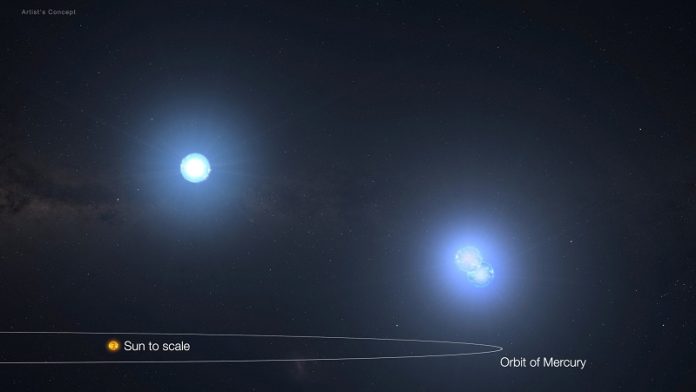
A unique triple star system, named TIC 290061484, has been discovered by a team of professional and amateur astronomers with the help of artificial intelligence (AI).
This extraordinary system was found through NASA’s Transiting Exoplanet Survey Satellite (TESS), which captures tiny changes in light as stars pass in front of each other.
In this newly discovered system, two of the stars orbit each other every 1.8 days, while the third star orbits the pair every 25 days.
This discovery sets a new record for the shortest orbital period for a third star in a triple system, beating the previous record set in 1956, where the third star orbited in 33 days.
“We’re able to study this system closely because the stars’ orbits are almost perfectly aligned with our line of sight,” explained Veselin Kostov, a research scientist at NASA’s Goddard Space Flight Center and the SETI Institute.
This alignment allows astronomers to measure the orbits, sizes, temperatures, and masses of the stars, offering insights into how the system formed and how it might evolve over time.
The research, led by Kostov, was published in The Astrophysical Journal on October 2.
The system was detected through subtle dimming in the stars’ light, which occurs when one star passes in front of another in a phenomenon known as an eclipse.
These flickers in light were identified by using machine learning to sift through massive amounts of data collected by TESS. A team of citizen scientists further refined the search, identifying this rare triple star system.
This group of citizen scientists, co-authors of the study, initially met during an online project called Planet Hunters, which ran from 2010 to 2013. They later formed the Visual Survey Group, which has collaborated with professional astronomers for over a decade to search for unusual star systems.
Triple star systems like TIC 290061484 are incredibly rare, but astronomers believe many more are waiting to be discovered across the galaxy. Because the three stars in this system orbit in almost the same plane, the system is very stable, even though their orbits are tightly packed.
The entire system fits within an area smaller than Mercury’s orbit around the sun, yet the stars don’t disturb each other much due to their aligned orbits.
However, the likelihood of planets forming close to these stars is slim. “The stars likely formed together, which would have disrupted any nearby planet formation,” said Saul Rappaport, a professor at MIT and co-author of the paper. Still, there may be a distant planet orbiting all three stars as if they were one.
In the future, one of the inner stars will expand as it ages, eventually merging with its twin and causing a supernova explosion in 20 to 40 million years.
Astronomers are continuing to search for triple star systems with even shorter orbits. Although it is challenging with current technology, NASA’s upcoming Nancy Grace Roman Space Telescope will provide sharper images than TESS, allowing astronomers to look deeper into the galaxy’s crowded center.
This new tool is expected to uncover even more triple star systems, as well as reveal other star systems with larger groups of stars orbiting each other.
“We’re excited to see what new discoveries lie ahead,” said co-author Brian Powell, a data scientist at NASA’s Goddard Space Flight Center. “Roman could reveal star systems we’ve never imagined.”
Source: NASA.



